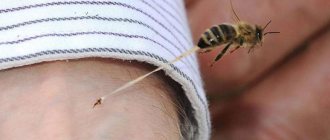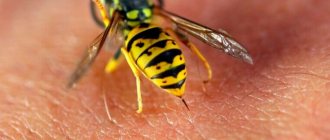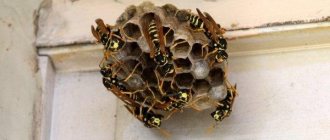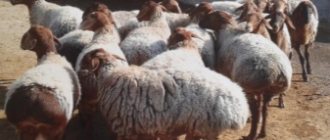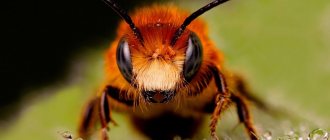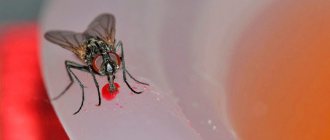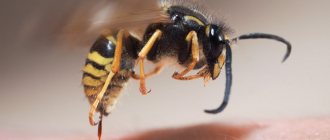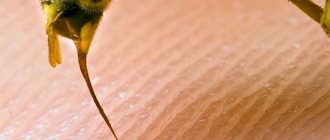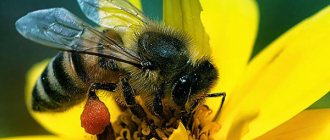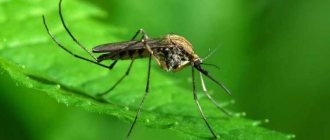Where is a bee's sting located?
The bee sting is located at the end of the insect's abdomen and is used solely for the purpose of protection. The bee never attacks unless it senses danger. Since the insect's abdominal structure is flexible, the blow is always delivered accurately. The sting penetrates under the skin thanks to serrations that can only be seen under a microscope.
At the moment the sting penetrates the skin, 0.3 mg of poison enters the body. Due to its poisonous glands, the sting, after piercing the skin, continues to act for a long time. Therefore, it is necessary to remove it as quickly as possible.
Bee sting
After the blow is struck, not only the one who is stung by the insect suffers, but also the bee itself. Since it immediately forms an open wound, which causes the death of the insect.
The bee sting is a special organ, essentially being a modified ovipositor. That is why it is completely absent in drones. The structural features of an organ can only be examined using a microscope. It has a complex structure, externally resembling a sharp long needle with a very thin base. Small notches are clearly visible on both sides, with their sharp tips directed towards the base. It should be noted that in worker bees the number of such notches is 10, while in the queen bee it is only 4.
A bee sting includes several main elements:
- three chitinous parts with plates;
- middle part: represented by a sled, widened in front and narrowed in back;
- stylet: it consists of two lancet needles, which are located in the hollow of the sled from below. During the bite, the stylet breaks and releases the needle.
Moreover, each of the elements has its own unique purpose. The stiletto allows you to pierce the skin. In the middle of the sled there is a poisonous gland, consisting of a bladder and a thread-like lobe. A toxic substance is formed in the reservoir bubble, which is injected under the skin. The bee's sting is located at the tip of the insect's abdomen.
The bee has a flexible and well-developed abdomen, so it always bites accurately, quickly and directly to the target. With the help of barbs, the needle penetrates deep into the enemy's body. However, after stinging, the bee itself is left with an open wound, since part of the abdomen is torn off along with the sting. As a result, after one bite the insect overtakes death.
Alarm pheromones in bees
During an attack on a bee colony by a wasp or hornet, anxiety can change the behavior of the colony. Characteristic sounds arise, the bees' temperature rises, and the number of bees ready to attack increases. Also, conferomone levels increase. By the way, even a person can smell the poison.
Previously, there was an opinion that due to the smell of poison, which is released by an excited bee at the moment of sting, other bees are mobilized to attack. But, in our time, it was determined that the toxic substance does not contain elements that can cause an alarm reaction.
Such a pheromone is considered to be isoamyl acetate, which is secreted by glands located at the base of the bee sting . A bee subjected to an irritable reaction of isoamyl acetate immediately acquires a characteristic posture. Namely, the abdomen raised upward, the tip of the sting protruding outward with a drop of poison appearing. Bees in this state begin to secrete an alarm pheromone themselves. At the same time, they flap their wings more intensely to spread it faster.
Why does a bee sting?
It's quite simple. The insect senses danger, and its body automatically triggers a defense mechanism. As a result of this, the sting instantly jumps out and hits the victim. Thus, the sting provides a protective function.
In order for an insect to show defensive activity, it must be provoked. It is important to remember that for a bee, its sting is fatal. This means that it only stings those in whom it sees a clear source of threat.
In a safe and calm state, there is no need to be afraid of bee colonies. However, not all so simple. It is not only direct human action that can cause aggressive behavior in an insect. The causes of the bite are:
- pleasant or unpleasant pungent odor;
- color and brightness of clothing;
- the smell of smoke, because insects are sensitive to fires that can destroy their hives;
- feeling the poison of a relative.
What kind of organ is this and what are its dimensions?
A bee's sting is an organ measuring from 2 to 4.5 mm, which it inserts into the body of its offender, injecting poison, which causes pain and burning. Interestingly, the poison in the sting continues to be released even after the bite.
The sting has two parts:
- Motionless. It consists of: sled;
- sled processes;
- oblong plates;
- palps.
- triangular plate;
A bee needs a sting for defense, but it can only sting once, after which it dies. The fact is that when struck, the sting remains under the skin of the offender, and without it the bee cannot exist, since it is part of its body.
Nervous system and behavior of bees After being stung, the bee flies away from the offender with an open wound and dies.
How does a bee sting work?
The bodies of bees differ - their structure depends on the functions performed in the family, so queens, drones and workers have different anatomy. The sting can be up to 4.5 mm long. It is necessary for protection from other insects and animals. In case of danger, the bee sprays poison that causes burning and pain.
The sting, consisting of a fixed and movable section, is located on the bee's abdomen. In a calm state, it is hidden under the joint. This weapon is attached to the body and intestines with thin films for protection. The fixed section includes an unpaired middle part - a sled about 2.5 mm long, looking like a trench. Their front part widens slightly, and the back, on the contrary, narrows and ends with a sharp groove. In front of the sled, arched lateral processes diverge, between which there is a fork with sting muscles. Elongated plates are attached to the processes from above.
Bees and their structure vary depending on the duties they perform in the hive. In any case, an insect bite does not pose a threat to human health. The only exception is the presence of individual intolerance.
The movable section includes two styles - these are thin needles, at the end of which there are notches. The queen bee has 5 such notches, while the worker bee has 10. Along the entire length of the stylet there is a large longitudinal notch that extends onto the roller of the sled. Thanks to this connection of stylets and sleds, movement is carried out. The cavity formed by them is a channel through which the poison flows.
Common questions about bee stings
Do young bees that have just left the nest have poison?
Young animals that emerged from the cells less than a day ago cannot sting. The poison is produced on the second or third day of life, and in sufficient quantities only after 10 – 18 days.
How long can swelling last after a bite?
With timely assistance and proper treatment, pain and swelling subsides within 1 to 2 days. But if you have an allergy, the swelling can last up to 7 days.
Does frequent bee stings affect the beekeeper's health?
Apitoxin, in addition to being harmful, has a positive effect on human health. In the absence of allergies, it is able to regulate the function of the pituitary gland, stimulate the formation of corticotropin, which stimulates the work of the adrenal glands. Therefore, frequent bites help increase the body’s defenses, strengthen memory, and reduce psychological stress.
Is it possible to develop immunity to apitoxin?
The body's reaction to a bee sting is variable. With regular exposure to poison, susceptibility to it gradually decreases. But it is worth remembering that if you are allergic to one or more components, the negative reaction, on the contrary, will intensify.
How does the level of intoxication depend on the number of bites?
If a significant amount of apitoxin enters the body, it can lead to serious negative consequences. After 100 or 200 bites, blood pressure drops sharply, nausea, vomiting, dizziness, and fainting appear. Bites are especially dangerous for children and women. Men are less susceptible to poison. Simultaneous stings from 250 bees can lead to rapid death.
Single bee stings do not cause serious harm to the body; you just need to remove the sting and properly treat the wound. If you have a tendency to allergies, it is imperative to use antihistamines and receive medical help.
Causes of bites
Experts say that these insects sting only in the most extreme situations. And the voluntary desire of a bee to attack a person is an exception to the rule rather than a pattern. In order for her to attack, she must first be provoked to such actions.
A bee begins to attack only in those cases when it begins to think that a person may pose a danger to it and, as a result, become a source of serious problems. For example, bees bite when they become confident that a person can destroy their hive or take their honey. Based on this, one of the main attributes of a beekeeper is a protective suit.
Bees also attack when they believe that a threat is hanging over them. Therefore, if you hold an insect in your palm, it will certainly sting its offender.
But the reasons for a given insect bite are not always as obvious as in the cases described above. For her behavior to become aggressive, sometimes the following factors are sufficient:
- Strong smell. In order to provoke a bee to sting, you just need to perfume yourself with eau de toilette with a pronounced odor. In its absence, the bee may also react negatively to the strong smell of sweat.
- Color of clothes. It has been proven that people wearing dark clothes are stung by bees more often. Therefore, the practice of wearing white protective suits has long been common in beekeeping.
- The smell of smoke. It can also cause an insect attack. Bees quickly recognize impending fires that destroy their homes, so this problem is one of the most pressing for these insects. Therefore, when encountering a bee after a fire begins to flare up somewhere, the person who gets in its way runs the risk of being attacked by it.
- Bee venom. When this insect bites, other bees may appear if they smell the poison of their relative.
In addition, it is also worth paying attention to the fact that not all bees bite the same way. Insects living in different regions of Russia have different attitudes towards humans. Carpathian representatives of this class are the calmest. While Central Russians and Caucasians can behave unfriendly even for no apparent reason.
Do all bees sting?
In fact, not all bees sting. As already noted, due to their physiological structure, male drones cannot sting. Their main function is to fertilize the uterus, so they do not need to protect the swarm. In addition, “well-fed”, frightened by smoke and swarming insects are not capable of stinging. In the wild, there is an unusual species of bees in which the stinging organ is not developed - melipons. Such insects bite the victim with their jaws.
Wild bee sting
Wild bees are practically no different from domestic ones, but they have a more aggressive character, which was formed as a result of insects being in the wild, where they often have to defend themselves. Quite often, wild individuals attack without warning or apparent reason, so they are considered more dangerous than domestic ones.
In addition, the venom of such insects is more toxic, which is why their bite poses a serious danger to humans, especially to small children. A massive attack by wild bees in most cases ends in death, so a person needs to avoid such insects, as well as know the rules of first aid and be able to provide it.
House bee sting
By their nature, domestic bees are less aggressive and attack only in case of a real threat. A single bite does not pose a great danger to humans and, with special therapeutic measures, quickly passes without consequences. Health risks can arise when stung by several individuals at the same time.
Did you know? Beekeepers who are often stung by bees practically do not react to the sting, since they develop temporary immunity to the poisonous substance. If the stinging process occurs systematically, then a person can easily endure up to 15 bites at the same time.
It should be noted that a bee is not able to sting if its crop is filled with honey during the honey collection process. For this reason, when beekeepers approach the hive, they smoke it. Such events serve as a signal for pets to collect sweet treats.
What does a bee sting look like after a sting?
During contact with the enemy, the bee defends itself and stings. In preparation for an attack, the insect lowers and bends its abdomen, then exposes part of its sting. After being stung, when the insect tries to fly away, the sting is torn off, since the barbs do not release it from the body.
Structurally, the sting looks like two elongated stylets that extend from the abdomen along special structures. When the insect is at rest, these formations at the rear end of the body are closed with special plates that move apart at the time of attack.
Prevention from bee stings
The best treatment for bee stings is prevention. It is especially important to ensure maximum safety for people prone to allergies.
The following professional measures will help you protect yourself from insect attacks:
- if contact with bees is necessary, use a special suit or clothing with sleeves;
- when working in an apiary or going into nature, do not use perfumes or perfumes, as they attract insects;
- do not come close to hives or nests of wasps, wild bees without a special suit;
- If there are nests located near residential buildings, call a special service that will eliminate the danger.
Functions of the sting and features of bee venom
The main function of a bee sting is to protect the swarm and its home by introducing a toxic substance into the body of the intended enemy. From the very beginning of evolution, bees did not have such an organ, but over time, the ovipositor in the 11-12 segments of the abdomen transformed into a sting and turned into a self-defense organ.
Potential dangers for insects may include:
- wasps;
- foreign bee colonies;
- hornets;
- animals - bears, hedgehogs, rodents (in particular, rats and mice);
- lizards.
Scientists who studied the composition of bee venom discovered a huge range of valuable components in it, in particular:
- melitin is the basis of the poison, which is a protein substance or peptide that has the ability to destroy bacteria;
- 13 amino acids and various compounds.
The functioning of the gland responsible for producing poison will depend on the age of the insect. A young bee has a minimal amount of toxic substance. But already a week after the insect is born, the reservoir with poison is completely filled. The maximum volume of the substance is accumulated on the 15th day. “Older” insects that have reached the age of 19 days cope especially well with the function of protecting the hive.
In what situations does a bee sting?
For those who plan to live in the country for a long time, this question is especially relevant. Bees use their weapons extremely rarely - only in exceptional cases, and not for attack, but for defense, when they encounter a serious threat. But there may be other circumstances:
- Strong smell. Sensitive olfactory receptors help to recognize the aroma of flowers over vast distances. An insect may attack if it senses something unusual and frightening - for example, the strong aroma of perfume or sweat.
- The smell of smoke. Instinctively, the insect senses danger, because such a smell may indicate a forest fire. Therefore, she tries to escape and in panic can sting everyone who meets on the way.
- Clothing in dark colors. Beekeepers note that bees react differently even to the color of clothing - dark shades cause aggression in them.
- Poison from other bees. If you are bitten by one bee, then others may attack - they will feel the poison, which will be a signal for an attack.
When they sting
Both scientists and experienced beekeepers confirm that bees sting only in exceptional cases . They don’t do it just like that; a bee attack is the exception rather than the rule. The attack is carried out only when the insect begins to believe that the person poses a real threat to it, that it can cause dangerous problems. For example, when a bee thinks that a person can do something negative towards the hive, or encroaches on honey.
This is why beekeepers constantly need protective suits, because they give the bees the most reason to attack. A bee also stings if danger threatens it personally. For example, if you start squeezing a bee in your hand, then, feeling that it can be killed, it can easily use its sting.
Other reasons
These are quite logical and obvious reasons, but there are also a number of non-obvious ones, when bees sting, but at first glance it is not clear why they do this. But, if you look in more detail, the reasons still become clear. One of the most common examples is an overly strong odor . Even very strong spirits are enough for the insect to react and launch an attack. Even if there is no perfume, it can react to the pronounced smell of sweat.
Interestingly, the smell of smoke can also cause bees to attack people, although this may not seem entirely obvious. But the point here is that bees instinctively recognize the danger of forest fires, which destroy their hives, and therefore are one of the most serious dangers for them.
What does this have to do with man? The fact is that if a forest fire occurs, then any bee tries to leave its shelter along with the honey as quickly as possible and find a new safe place. If any obstacle is encountered along the way (and a person is precisely such an obstacle), then the insect reacts to it quite aggressively and tries to “eliminate” it if possible.
Another factor that bees react to is, oddly enough, bee venom. If you are stung by one bee, then the reaction of other bees to you will change dramatically. They will sense this poison - and it may become enough of a motivator for them to attack you.
How long does a bee live after stinging a person?
Once a person is stung by the shoulder, death occurs within seconds.
The lifespan of a bee after stinging a person is only a few seconds. In the event of an attack not on people and animals, but on insects with a soft chitinous cover, there is a high chance of surviving by easily removing the sting after a bite.
A bee may not always use its weapon. If there is a lot of honey in its abdomen, then it is unlikely to sting.
How to fight
Wild bees settle in forest areas. Nests also appear near human habitation. Such a neighborhood frightens people because they are aggressive in nature.
You can get rid of “neighbors” in different ways:
- Protect the area from insects with a high fence. Flying over a large barrier is very tiring for wild honey plants; they will look for a more accessible place to “work.”
- Lavender bushes planted on the site will protect the area from uninvited guests.
- Fumigating indoors and outdoors with herbs with a strong aroma (mint, oregano, sage) will drive away unwanted neighbors.
- You can get rid of the swarm by handing it over to a beekeeper. The beekeeper will help catch the family and move it to a sufficiently distant distance from the old place.
- Earth species do not cause any harm. If the nest interferes with planting work, it is poured with boiling water or treated with pesticides.
In order to preserve the population of honey bees, wild bees were included in the Red Book. They disappear. By protecting the gene pool of insects, an important niche in the planet’s ecosystem is preserved, and people use the unique product of bee activity - honey.
Bee sting process
The bee's stinging apparatus is considered an ideal designed automatic weapon.
It is possible to examine the very moment of the sting only with the help of macro photography.
Contact of the bee's abdomen with the skin surface
In the seventh, that is, the last, cone-shaped region of the bee's abdomen there is a narrow gap. The gap leads into a chamber in the form of a bag, inside which the stinging apparatus is located. This is exactly what we can observe at the moment of the bee’s calm state.
The cavity of this chamber also contains the opening of the oviduct and the anus of the rectum. The anus of both the queen and the worker bee opens into the cavity of the sting chamber. During bowel movements, the anus moves slightly outward. Due to this, excrement does not fall into the chamber.
During the bee's calm state, the piercing part of its sting is hidden in a case, which rises during an attack. At the same time, the piercing part of the bee's sting lowers and thus comes out.
During a sting, the bee's abdomen can be positioned arbitrarily, but despite this, the stinger strikes by moving the bee's sting rod down and then back. In the case where no sting occurs, the sting is retracted and raised into the chamber. At the same time, the case is lowered and the stiletto is closed.
For the first time, the anatomy of the structure of a bee’s sting was outlined by Swammerdam in his work “The Bible of Nature.” Later, this anatomy served as an object of study for many authors. For example, Zolman and Fenger, Kraepelin and Snodgrass.
At rest, the stylet of the sting, that is, its piercing part, is hidden in the case, and the sting itself is involved in the chamber.
After the bee's sting begins to descend, the case will rise. At the same time, the end of the bee’s abdomen will begin to bend, preparing for the action of stinging, and the piercing part will approach the exit of the chamber.
After lowering the sting, it comes out of the chamber. Thanks to the muscles, the sting case is raised as much as possible. From the gap in the last area emerges a thin stiletto, the very piercing part of a bee’s sting.
Anchoring a bee stinger
This concept refers to the entire process of stinging, from the prick of the tip of the sting to the eversion of the stinging apparatus from the back of the bee.
How does this action take place?
The tip of the sting (approximately 1/3 of the total sting) bifurcates into two sharp stilettos. Therefore, the stinging bee can only penetrate a third. On paired stilettos, the tips of the bee sting are arranged with 9-10 teeth in the shape of triangles. These toothed triangles have the outer corners pointing back, like a fishhook.
The teeth of the stilettos practically do not interfere with the penetration of the tip of the sting itself into the skin, but make it impossible to extract it back. For example, a wasp will be able to sting and then retract its smooth, non-serrated stinger.
The sting of the queen bee has up to four teeth. After a very superficial sting, she never leaves it in the beekeepers’ hand. For the queen, the most important task is to continue the bee family.
Once the sting has penetrated the skin, it becomes stuck there. Due to the further increase in the pressure of the sac-like chamber on the walls, the modified eighth and ninth abdominal segments are pushed out. That is, triangular and square plates. From this moment on, the abdomen will no longer be able to push the bee’s sting, and the next stage begins.
Spontaneous detachment of a bee sting
At this stage of stinging, the bee is no longer able to exert any mechanical influence on the stinging apparatus. She only tries to break away from the skin and fly away. At the same time, the bee pulls its sting back, but the entire stinging apparatus is torn off.
Venom glands begin to appear from the bee's abdomen in the form of transparent bubbles. Simultaneously with the sting, the last ganglion of the nerve chain is torn off. Thanks to this nerve, the bee's stinger operates autonomously.
Literature
- Chauvin R.
From bee to gorilla. - M., Mir, 1965. - 295 p. - Butler K. J.
The world of the honey bee. - M., 1980. - 232 p. - Vasilyeva E. N., Khalifman I. A. Bees. - M., 1981
- Radchenko V. G., Pesenko Yu. A. Biology of bees (Hymenoptera, Apoidea).
SPb.: Zool. Institute of the Russian Academy of Sciences. - 1994. - 350 p. - Greenfeld, E. K., 1978. The origin and development of anthophyly in insects
. - L.: Publishing house of Leningrad State University. — 203 p. - Eskov E. K. (1992). Ethology of the honey bee. M.: Kolos. 336.
- Eskov E. K. (1995). Ecology of the honey bee. Ryazan: Russian Word. 392 pp.
- Eskov E.K. (2013/2014). Biology of bees: encyclopedic dictionary-reference book. Publisher: Infra-M. 387 p. ISBN 9785160051277
- Eskov E. K. (2016). Evolution, ecology and ethology of the honey bee. M.: Infra-M. 291 p.
- Key to insects of the European part of the USSR. T. III. Hymenoptera. First part. // Suborder Apocrita – Stalk-bellied
(Arnoldi K.V. et al.) / under the general. ed. G. S. Medvedeva. - L.: "Science", 1978. - P. 279-518. — 584 p. — (Key guides to the fauna of the USSR, published by the Zoological Institute of the USSR Academy of Sciences; issue 119.). — 3500 copies. - Danforth, B. N., J. Fang, S. Sipes, S. G. Brady & E. Almeida (2004). Phylogeny and molecular systematics of bees (Hymenoptera: Apoidea).
Cornell University, Ithaca, NY Phylogeny of bees - Donovan, B. J. 2007: Apoidea (Insecta: Hymenoptera).
Fauna of New Zealand, 57. - Engel, M. S. (2005). Family-group names for bees (Hymenoptera: Apoidea).
American Museum Novitates 3476: 1-33. pdf - Michener, C. D. (2007) The bees of the world, second edition.
Johns Hopkins University Press, Baltimore and London, 953 pp.
Differences from a wasp sting
A bee's sting differs from a wasp's:
- When a wasp stings, it inserts a sting into the soft body of its enemy, which is possible due to the presence of barbs. The sting has a saw-shaped stylet made of hard chitin, inside of which there are 2 lancets. The sting has a point, making it easier to insert into the body, and glands filled with poison.
- Unlike a bee, after a wasp stings, it does not die and can even sting several more times. The wasp's sting has much smaller serrations, so when they are removed back from the body, they do not cling very much. In addition, there is no knot at its tip, so the wasp can easily remove the sting.
- Individuals sting in different ways. The wasp is an aggressive insect, so it can sting or simply bite with its jaws. She doesn’t need a reason - just a wave of her hand or a scent that is unpleasant to the insect is enough. Its bite is very painful, often causing swelling and inflammation, especially if it was done by a large insect. A bee stings only when it needs to protect the hive.
- After a wasp bite, there will be no sting in the wound, but a bee sting will remain sticking out like a splinter. A bee sting is less painful than a wasp sting.
Difference between the sting of a worker bee and a queen bee
The worker bee's sting is a protective device. The uterus has a curved sting with 3 serrations. She freely pulls him out of the wound and can sting him several more times. The queen uses her sting only in a fight with another queen (if by chance a rival gets into the hive, they enter into a fight that ends in the death of one of them).
In exceptional cases, if the uterus is not yet fertilized, it can sting a person. The sting is not painful at all, but sometimes the area where the person's skin was pierced will feel somewhat itchy for several days.
The queen's sting is also an ovipositor, apparently, which is why she avoids using it as a weapon of defense and attack.
The fertilized human uterus never stings.
Bee venom
Bee venom is a very useful substance. Otherwise, it is called apitoxin, and according to archaeological excavations, this substance has been used by people for healing purposes since ancient times. Modern technologies have made it possible to study the exact chemical composition of this poison. Its main components are proteins such as melitin and adolapin. They have a very strong anti-inflammatory effect on the body. In addition, scientists are actively testing melitin as a substance that fights cancer cells. It was noted that this substance has the ability to destroy the membranes of malignant cells within an hour. And it may well eliminate all tumor tissue. In addition, melitin deprived these cells of nutrition and thus stopped their growth and proliferation. So what happens if a bee stings a bee? And is this possible?
Bees pose quite a danger to humans, especially in large numbers. But the bite of even one insect can cause death in those who are allergic to bee venom. Despite this, this type of insect lives in almost all corners of planet Earth. And their home, a bee hive, is a real factory for the production of honey, wax, propolis, beebread and other useful substances. These workers are well organized and almost constantly busy with their daily affairs. But could it happen that the system fails and a bee bites its fellow bee?
Harm and benefits of bee venom
It is believed that humans receive nutrients through insect secretions. Doctors call this process bee apitherapy. The poison has a complex composition:
- sulfur;
- manganese;
- stearins;
- amino acid enzymes;
- nitrogen;
- fructose;
- glucose;
- phosphorus;
- iodine;
- chlorine.
The set of substances in bee secretions is similar in composition to the components of a strong antibiotic. They retain their antibacterial effect throughout the duration of the poison's action, even after the death of the insect.
Interesting! Scientists noted that the secret can be used to create new drugs. The components of bee venom remain sterile for several days. The substance can be diluted to a ratio of 5000:1 without loss of benefit. Therefore, despite the tiny dose, it remains useful and effective for humans.
Bee secretion has the following features:
- destroys E. coli;
- kills staphylococci, streptococci;
- diphtheria pathogens will be destroyed from exposure;
- bacteria and viruses die.
The mechanism of action of the poison is not lost even when water is heated to the boiling point. It has a strengthening effect on the human body, increasing immunity. It also dilates blood vessels and enhances the diuretic effect. When blood thins, blood pressure normalizes and hemoglobin levels increase. In some medicines, bee venom is needed to reduce fever in children and adults and improve metabolism.
Despite its benefits, bee venom has one significant drawback. It is contraindicated for people diagnosed with individual intolerance. In such cases, you don’t have to be afraid of only males, since drones don’t bite. Worker bees sting and have a long nose. Males cannot provide themselves with food; they live only at the expense of the worker colony.
.
Who stings more
Not every person can objectively assess painful sensations. Not everyone has been bitten by both animals. American entomologist Justin Schmidt asked this question and decided to compare the sensations obtained from the bites of various insects. Over the course of several years, the scientist subjected himself to attacks by several thousand insects, after which he recorded his observations and sensations. After his experiments, he invented the scale. According to this scale, a wasp sting is like burning the tip of your tongue with a cigarette. He compared a bee sting to a skin burn from an open fire. Schmidt notes that in most cases a wasp sting is more unpleasant, but the peculiarity of a bee sting is that, due to the teeth, the sting gradually goes deeper and deeper into the skin, prolonging the painful sensation.
He compared a bee sting to a skin burn
How can a person avoid a bee sting?
In order to minimize the risk of a bee sting, do not make sharp sounds near the apiary, remember that insects can react aggressively to the strong odors of perfume, powder and other products.
To avoid becoming a target for insects, it is better to follow simple rules:
- Do not use perfume in your summer cottage, so as not to attract bees with a strong aroma.
- In places where bees are likely to appear, it is better to wear light-colored clothing.
- Do not eat sweets or drink sugary drinks in possible places where bees appear, and also do not leave half-eaten fruits at your summer cottage in the summer.
- Try not to make sudden movements when you see a bee, so as not to scare it.
How to provide first aid and what to do after being stung by a bee, watch the video.
Now you know why a bee dies after stinging, and also how long a bee lives after stinging a person. You should not be afraid of single bites if you are not allergic to the venom of these insects. Try to follow simple safety rules and a dangerous incident is unlikely to happen. But if a peace-loving summer resident or city dweller is nevertheless attacked by a bee, then you should calmly provide first aid, information about which is presented step by step in this article.
What to do if stung by a bee?
The sting of one bee is not dangerous to human life, since the amount of poison injected is only 0.1-0.3 mg. But if a swarm attacks, its level can rise to 0.25 g, and this dose is considered lethal. In addition, a lot depends on the location of the sting. It is especially difficult to tolerate on the face, lips, eyes, and neck. People die not so much from insect venom as from suffocation due to swelling of the neck or tongue.
In any case, the sting must be quickly removed from the resulting wound, since the poison will be released through it even after the bite. In this case, the person will experience burning pain. If the correct measures are not taken, swelling and hyperemia will occur at the site of the bite. In severe cases, the wound may become inflamed.
Many beekeepers who are stung frequently have little reaction to the sting as they develop temporary immunity. A person can experience 10 to 15 bee stings if they happen regularly.
Help for a bite without allergy symptoms
If there is no allergy, then symptoms will appear in the form of slight swelling and itching. This suggests that the bite is not life-threatening. To provide first aid, use:
- ice or cold water;
- baking soda;
- antihistamine;
- painkiller.
Follow the following sequence of actions:
- Remove the sting as soon as possible. If it sticks out on the surface of the skin, then use a fingernail and grab it with your fingers. You should not use tweezers, as pulling may release more poison. You can’t squeeze him out!
- The resulting wound is washed under running cold water, using liquid soap to disinfect the area.
- Take antihistamines. For example:
- Cetirizine;
- Tavegil;
- Suprastin;
- Fenistil;
- Zyrtec;
- Erius.
- Treat the wound with antiallergic cream. You can apply a damp cloth soaked in a baking soda solution to this area. The solution is prepared at the rate of 1 tsp. for 1 glass of water. If you don’t have soda, you can replace it with hydrogen peroxide, a weak solution of potassium permanganate, salt water, 0.25% ammonia, 6% vinegar. Do not scratch the bite site!
- Cold is applied to the wound to relieve pain symptoms and quickly spread the poison. Cold prevents swelling. This could be ice or a towel soaked in cold water.
- For severe pain, take painkillers:
- Aspirin;
- Ibuprofen;
- Nurofen.
- Drink plenty of fluids.
Help from a bite with allergies
A bee sting cannot be fatal to a person, however, if he is allergic to bee venom, then everything becomes significantly more complicated. Unfortunately, many people learn about allergies only after being stung by a bee.
Insect venom is a mixture of protein compounds. Some people react to them by developing an allergy, leading to serious consequences in the form of Quincke's edema and anaphylactic shock.
Allergy symptoms after a bite are as follows:
- severe swelling;
- pressing feeling in the chest area;
- difficulty breathing;
- the presence of red itchy spots throughout the body, urticaria;
- headache;
- weakness;
- nausea and vomiting;
- elevated temperature;
- convulsions;
- pain in the lumbar region and joints;
- loss of consciousness.
With such symptoms, you should urgently call an ambulance.
The actions carried out to provide first aid are as follows:
- Use an epinephrine pen if the victim has one. Usually, allergy sufferers always have it with them.
- Unbutton the collar and loosen the tie so that the victim can breathe easier and the clothing does not constrict.
- Lay the victim down, and then cover him and cover him with heating pads with warm water.
- Give 25 drops of Cordiamine to support the heart.
- If there is bleeding from the nose and vomiting, turn the victim onto his side.
- Lower the bite site below the level of the heart so that the poison moves slowly through the blood.
- Call emergency medical assistance immediately.
After assistance, swelling may persist for 1-5 days, and on the face for about a week.
Are bees killers?
It is worth noting that bees do not bite their relatives very rarely, this is not something strange. And there are several reasons for this. For example, when strangers from another colony try to break into a hive and steal honey, members of that hive begin to attack it. However, when faced with a more serious threat, such as hornets, the bees act together.
They stick tightly to it on all sides and actively vibrate with their wings. This increases the concentration of carbon dioxide inside the circle. And the hornets die. In addition, among bees there is an unusual individual who is the queen of the hive. And she absolutely does not tolerate competition. When another queen appears among the new offspring, the current queen destroys her by biting with her stinger. This individual uses its sting only for these purposes. It also happens that bees bite their relatives, who are slightly different from them. The degree of the sting varies, so the bee can kill, or it can simply scare away the uninvited guest from its territory.
Appearance
These insects belong to the Hymenoptera. The first external difference is in size; due to the fact that there are thick hairs on the bee’s body, it appears larger.
In addition, they differ in color:
- Bee. The body is painted in a pale yellow color, on which there are intersected stripes of a dark shade. Dark colored paws. The body has a round shape and is covered with very thick hairs. Depending on what role an individual plays in the hive, there are differences in the shape of the abdomen. The workers who collect nectar have an egg-shaped abdomen. The queens have an oblong shape, while the drones are larger and truncated. There are baskets on the paws that are designed for storing pollen and nectar.
- Wasp. They have a very elegant appearance. The abdomen, head, and paws have a bright yellow color, on which a clear black pattern can be seen. There is a thin belt between the chest and abdomen. The body has an elongated shape. You can note the thin legs of these insects and fairly strong jaws.
You can see how they look in the photo.
Comparison of the stinging process in bees and wasps
Bee and wasp stings are characterized by high pain, discomfort, itching, possible development of swelling, and can bring serious trouble to a person.
Meanwhile, the bites of the described insects have big differences, which are related to the chemical composition of the toxic substance:
- wasp venom is distinguished by the presence of alkalis, to neutralize which it is enough to wipe the affected area with vinegar;
- bee venom has a high content of acids, the effect of which can be neutralized with a soap solution or alcohol.
At the same time, the external signs of a wasp and a bee sting are almost identical:
- a swelling forms, the size of which will depend on the individual reaction of the human body;
- the area where the toxin is spreading appears red.
It is also necessary to note the structural features of the stinging organs. The wasp's sting has a smooth structure, without serrations, so it can be used by insects many times; the wasp remains alive. Individuals bite in different ways: the wasp is more aggressive and can attack for no reason, just wave your hands near it. Bees sting only when necessary to protect their hive. The bee sting is a unique organ that serves as a protective tool for the insect when danger arises.
Bees are fairly peaceful insects that, unlike wasps, bite only in exceptional cases. To avoid being stung, experts recommend avoiding hives, being careful and not provoking the insects again. If you are bitten, you should immediately take the necessary measures and be sure to seek qualified medical assistance.
Sources
- https://KlopaBei.ru/muhi-i-moshki/zhalyashchie-pchely.html
- https://MedBzz.com/pchely/zhizn/zhalyashchie-pchely.html
- https://pchela-info.ru/pchely/znachenie-zhala
- https://MedVoBlago.ru/produkty-pchelovodstva/ukus-pchely
- https://standartmebel.com/zhalo.html
- https://moyapaseka.ru/vse-o-pchelax/zhalo-pchely
- https://fishki.net/3624855-mozhet-li-pchela-uzhality-pchelu.html
- https://GdeKlop.ru/osy-i-pchely/sredstva-ot-napadeniya/
[collapse]
Stung by a wasp: first actions
This is not the first generation of parents who have used proven first aid actions for a wasp sting. The main thing is to do everything quickly.
What to do first? It is important to leave the scene of the attack, but you should not try to kill the wasp, especially if it is not alone. Such actions will most likely cause another attack
The sting may contain a large number of bacteria, so it is recommended to treat the bite site with an antiseptic
To do this, you can use hydrogen peroxide, alcohol, or, as a last resort, soap and water. To stop the spread of toxins, the bitten arm or leg is bandaged over the wound with a tourniquet or scarf. Drinking plenty of liquids: tea, compotes, water helps speed up the process of removing poison. You can relieve the pain by bandaging the bite site and putting something cold or just ice on top. Half an onion, tomato or apple also relieves symptoms well: you need to put it on the site of the bite.
After providing first aid, you should continue to monitor the condition of the victim, since swelling can begin either immediately after the bite or a day later. If the wound is very swollen (1.5-2 times) and the person complains of feeling unwell, consult a doctor.
